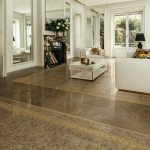Discovering the Durability of Tile and Porcelain Finishes
Durability is an important factor to consider when shopping for tile and porcelain finishes. After all, you want it to last as long as possible. But how can you tell which ones are more durable than others? This article will explore the different tile and porcelain finishes available on the market and show how you can use their unique properties to determine durability.
When browsing through tile and porcelain finish options, there are several key characteristics that help determine durability. For instance, the thickness of a material is a major factor: thicker materials tend to be more resistant to wear and tear. The material composition is also important: some materials such as ceramic or porcelain are naturally more resistant to damage than others like vinyl or laminate. Finally, glazes and coatings used to protect against abrasion can further improve a tile or porcelain surface’s durability.
Understanding the differences in these characteristics allows DIYers and contractors alike to make better decisions about selecting the right product for their home or business space. As an example, ceramic tiles typically have a higher level of moisture-resistance than other types of finishes. In this sense, they make an ideal choice for high-traffic areas such as kitchens or bathrooms where water spills are likely to occur. Similarly, thicker tiles with glazed finishes may be better suited for outdoor applications due to their increased protection against weathering or UV exposure.
In addition to understanding the unique properties of each product type, it’s also essential to know how certain maintenance practices can affect durability over time. To ensure continued longevity of your tile or porcelain surfaces, regular cleaning with mild detergents is important along with occasional sealing for extra protection from stains or scratches caused by dirt and debris coming into contact with them. Additionally, floor waxes should be used sparingly—too much wax could leave behind a slippery residue that could reduce traction on foot traffic surfaces where slips might occur.
Finally, sealing products designed specifically for tile and porcelain should always be used in order to prevent staining from oils (such as cooking grease) from seeping into their pores over time—this could result in discoloration of your surfaces if not addressed properly upfront! Also worth noting is that most sealants come in two forms: permanent/long-lasting coatings as well as temporary sealers which need re-application after several months depending upon your use case scenario(s).
So there you have it! With these simple tips in mind–along with a thorough understanding of tile and porcelain finishes–you’ll be able to find the best option suited for your needs while ensuring maximum longevity at the same time!
ENHANCING YOUR HOME WITH CREATIVE DESIGNS IN TILE AND PORCELAIN






